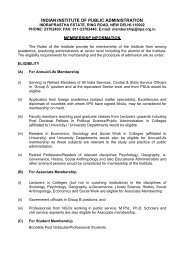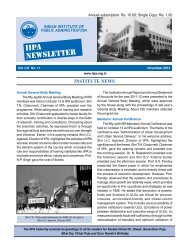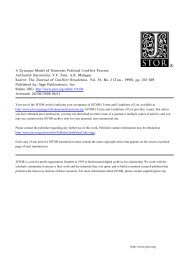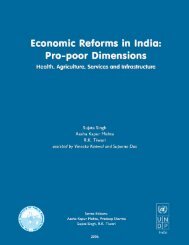<strong>Privatisation</strong> <strong>of</strong> <strong>Health</strong> <strong>Care</strong> <strong>in</strong> <strong>India</strong>Table 12: Trend <strong>in</strong> Utilisation <strong>of</strong> Outpatient Services <strong>in</strong> the Private SectorBetween 42 nd and 52 nd Rounds <strong>of</strong> the NSS(Percentage)States 42 nd (Urban 42 nd (Rural) 52 nd (Urban) 52 nd (Rural) Change Urban Change RuralMaharashtra 72.4 70.5 77 73 +4.6 +2.5Karnataka 65 60 74 51 +9 -9Orissa 42.4 31 53 31 +10.6 No changeINDIA 50 50 72 64 +22 +14Source: Compiled from Duggal (2006: 34-35)Table 13: Trends <strong>in</strong> Utilisation <strong>of</strong> Inpatient Services <strong>in</strong> the Private Sector Between42 nd and 52 nd Round <strong>of</strong> the NSS(Percentage)States 42 nd (Urban) 42 nd (Rural) 52 nd (Urban) 52 nd (Rural) Change Urban Change RuralMaharashtra 48 54 68.2 68.8 +20.2 +14.8Karnataka 50 38 78.2 54.2 +20.2 +16.2Orissa 15 7 19 9.4 +4 + 2.4INDIA 36 35 56.9 54.7 +20.9 +19.7Source: Compiled from Duggal (2006: 34-35)<strong>in</strong>crease (Table 13). This trend needs to be analysed furthernot only <strong>in</strong> the context <strong>of</strong> the <strong>in</strong>crease <strong>in</strong> the growth <strong>of</strong>private services, but also <strong>in</strong> terms <strong>of</strong> what has been happen<strong>in</strong>g<strong>in</strong> the public sector. The issues concern<strong>in</strong>g ris<strong>in</strong>gcosts <strong>in</strong> the public sector, the quality <strong>of</strong> care provided, and<strong>in</strong>crease <strong>in</strong> the costs <strong>of</strong> drugs have acted as push factorsfor utilis<strong>in</strong>g the private sector. What is <strong>in</strong>deed worry<strong>in</strong>g isthat the STs across states have shown very low levels <strong>of</strong>utilisation. This would mean that those who need care arenot seek<strong>in</strong>g care, because they cannot afford it and thereforemay not be seek<strong>in</strong>g care when they need it the most(Sen et al, 2002). In a sense, while the middle and uppermiddle classes can choose to use either the public or privatesectors, the poor may not be <strong>in</strong> a position to accesseither <strong>of</strong> them, because <strong>of</strong> the ris<strong>in</strong>g costs <strong>of</strong> medical care.Where the public sector is weak, this will def<strong>in</strong>itely affectutilisation by the poorer sections <strong>of</strong> the population. Clearlythere are important questions regard<strong>in</strong>g equity <strong>in</strong> this context.At the state level this calls for a rational use <strong>of</strong> availableresources and also for a policy that will strengthenpublic provision<strong>in</strong>g and regulate the private sector. In addition,other mechanisms like public <strong>in</strong>surance schemescould be given a serious thought to address some <strong>of</strong> these<strong>in</strong>equities and their consequences.28
ReferencesAcharya, A.; Baru, R. and Nambissan, G. 2001. ‘The State andHuman Development: <strong>Health</strong> and Education’ <strong>in</strong> Deshpande,G.P. and Acharya, A. (Ed.), Cross<strong>in</strong>g a Bridge <strong>of</strong> Dreams: 50 Years<strong>of</strong> <strong>India</strong> Ch<strong>in</strong>a, Tulika <strong>Public</strong>ation, New Delhi.Balambal, R.; Jaggarajamma, K.; Rahman, F.; Chandresekharan,V.; Ramanathan, U. and Thomas, A. T. 1997. ‘Impact <strong>of</strong>Tuberculosis on Private for Pr<strong>of</strong>it Providers’, WHO andTuberculosis Research Centre, Chennai.Balakrishnan, S. and Iyer, A. 1997. ‘Bangalore Hospitals and UrbanPoor: A Report Card’, <strong>Public</strong> Affairs Centre, Bangalore.Banerji, D. 1985. ‘<strong>Health</strong> and Family Plann<strong>in</strong>g Services <strong>in</strong> <strong>India</strong>:An Epidemiological, Socio-cultural and Political Analysis and aPerspective’, Lok Paksh <strong>Public</strong>ation, New Delhi.Baru, R.V. 1998. Private <strong>Health</strong> <strong>Care</strong> <strong>in</strong> <strong>India</strong>: Social Characteristics andTrends, Sage <strong>Public</strong>ations, New Delhi.Baru, R.V. 1993. ‘Inter-regional Variations <strong>in</strong> <strong>Health</strong> Services <strong>in</strong>Andhra Pradesh’, Economic and Political Weekly, May, 963-967.Bhandari, N. 1992. ‘The Household Management <strong>of</strong> Diarrhoea <strong>in</strong>Its Social Context: Study <strong>of</strong> A Delhi Slum’, Unpublished PhDthesis, Jawaharlal Nehru University.Bhargava, R. 2000. ‘Democratic Vision <strong>of</strong> a New Republic: <strong>India</strong>,1950’ <strong>in</strong> Frankel, F.; Hasan, Z.; Bhargava, R. and Arora, B.(Ed)., Transform<strong>in</strong>g <strong>India</strong>: Social and Political Dynamics <strong>of</strong>Democracy, Oxford University Press, New Delhi.Bhat, R. 1993. ‘The Private/<strong>Public</strong> Mix <strong>in</strong> <strong>Health</strong> <strong>Care</strong> <strong>in</strong> <strong>India</strong>’,<strong>Health</strong> Policy and Plann<strong>in</strong>g, 8(1).Bisht, R. 1993. ‘Understand<strong>in</strong>g Environmental <strong>Health</strong>: A Study<strong>of</strong> Some Villages <strong>of</strong> Pauri Garhwal’, Unpublished M.PhilDissertation, Jawaharlal Nehru University, New Delhi.Brown, E.R. 1984. ‘Medicare and Medicaid: Band Aids for the Oldand Poor’, <strong>in</strong> Sidel, V. and Sidel, R. (Ed.) Reform<strong>in</strong>g Medic<strong>in</strong>e:Lessons for the Last Quarter, Pantheon Books, New York.Bruntland, G.H. 2000. Speech to the WHO/<strong>Public</strong> Interest NGOPharmaceuticals Round Table, 3 rd Meet<strong>in</strong>g, Geneva, May 1.(available onl<strong>in</strong>e http://www.who.<strong>in</strong>t/director-general/speeches/2000/english/20000501_ngo.html).Budhkar, U. 1996. ‘<strong>Health</strong> Services Development: The Case <strong>of</strong>Maharashtra’, Unpublished M.Phil dissertation, JawaharlalNehru University, New Delhi.Carrasquillo, O.; Himmelste<strong>in</strong>, D.U.; Woolhandler, S. and Bor,D.H. 1999. ‘Trends <strong>in</strong> <strong>Health</strong> Insurance Coverage, 1989-97,’International Journal <strong>of</strong> <strong>Health</strong> Services, Vol. 29, No. 3, pp.467-483.CEHAT, IIT & JNU, 2001. ‘Private <strong>Health</strong> Sector <strong>in</strong> <strong>India</strong>: Reviewand Annotated Bibliography’, February.Duggal, R. 2006. ‘Utilisation <strong>of</strong> <strong>Health</strong> <strong>Care</strong> Services <strong>in</strong> <strong>India</strong>’, <strong>in</strong>Prasad, S. and Sathyamala, C. (Ed.), Secur<strong>in</strong>g <strong>Health</strong> for All:Dimensions and Challenges, <strong>Institute</strong> for Human Development,New Delhi.Duggal, R. 2001. ‘Utilisation <strong>of</strong> <strong>Health</strong> <strong>Care</strong> Services <strong>in</strong> <strong>India</strong>,Paper presented at the National Consultation on <strong>Health</strong> Security<strong>in</strong> <strong>India</strong>’, 26-27 July, New DelhiGovernment <strong>of</strong> <strong>India</strong>. 1946. Report <strong>of</strong> the <strong>Health</strong> Survey andDevelopment Committee (Bhore Committee). Vols. I and IV. Manager<strong>of</strong> <strong>Public</strong>ations, Delhi.Government <strong>of</strong> Karnataka 2001. Karnataka: Towards Equity, Qualityand Integrity <strong>in</strong> <strong>Health</strong>, The Task Force on <strong>Health</strong> and FamilyWelfare, Bangalore.29

















